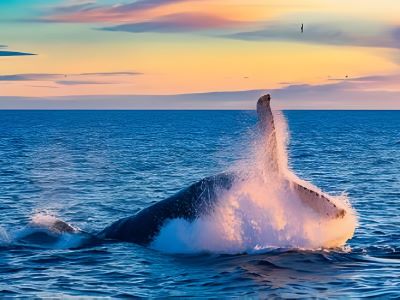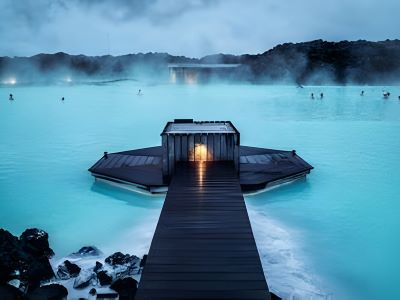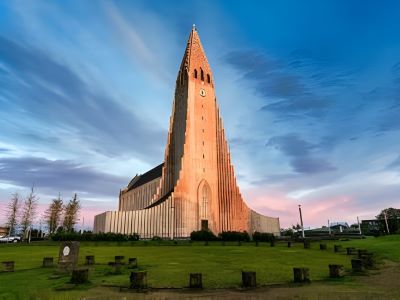Are you excited about planning a trip to Iceland but feeling a bit unsure about the best time to visit Iceland? No worries – I’ve got you covered!
Iceland is a truly magical destination with something special to offer in every season. From dancing under the Northern Lights to floundering in the wonder of the midnight sun, each time of year has its unique charm. In this unltimate guide, I’ll explain the best times to visit Iceland to experience Iceland’s beauty at its finest.
Get ready to uncover the secrets of this incredible country.
Best Time to Visit Iceland for Northern Lights
The best time to go Iceland for the Northern Lights is between September to late March. This is because the nights are dark enough, which will help you to witness aurora borealis in Iceland during these months. As we have an idea, Iceland’s midwinter days offer only 4-5 hours of daylight, which provides an ample amount of time to hunt for the northern lights. It is the best time to visit Iceland.
Iceland’s weather is unpredictable, so your travel plan should be flexible. Wait for the clear skies, and do not return home without experiencing this mesmerizing view.
If you’re keen on photographing, January is the best time to explore Iceland’s crystal blue ice caves. It is a rare treat experience. Moreover, the Jokulsarlon glacier lagoon will give you a spectacular northern lights view.

Best Time to Visit Iceland for Whale Watching!
When planning a whale-watching trip to Iceland, picking the best time is important. The best time to visit Iceland for whale-watching is summer, especially from June to August. During this time, the weather is nice, and the seas are calm, making it easy to spot whales.
As we know, Icelandic waters are home to various whale species, including humpback whales, minke whales, and majestic blue whales. During summer, they migrate to Iceland’s shores. In addition, the long daylight hours during the Icelandic summer provide more opportunities for spotting whale activities.
Furthermore, many whale-watching tours and cruises operate regularly during the summer, so there are plenty of chances to see whales, dolphins, etc…

Best Time to Visit Iceland Blue Lagoon
The Iceland Blue Lagoon is a geothermal spa. It is especially known for its mineral-rich waters and beautiful surroundings. Whichever season you come, I advise you on the best time to go Iceland Blue Lagoon: early in the morning or late in the evening.
Early morning visits offer a more tranquil experience. At that time, the lagoon opens, allowing you to soak in the mineral-rich waters with fewer crowds. The morning sunlight gives a serene atmosphere, and you will feel refreshed and rejuvenated throughout the day.
On the other hand, a late evening experience will give you a similar tranquil experience but with the charm of sunset views over the lagoon. It’s like soaking in the warm waters and releasing your day’s stress while enjoying the beautiful surroundings.
Each season has its perks, so your choice of exploring Iceland depends solely on your preference. In addition, the Blue Lagoon’s operating hours vary by season, so check their schedule and plan your visit accordingly.

Must-Try Icelandic Food
Get ready to dive into Iceland’s crazy food scene. Let me take you on a tasty trip to the best food in Iceland, which you can try on your visit.
You can start your day with some Skyr, creamy, dreamy stuff that’s like yogurt and will make your tummy full. Then, sink your teeth into some fantastic lamb raised on Iceland’s pure, green pastures.
Have you ever tried bread baked in the ground? No? You must taste Rúgbrauð – it’s dense, sweet, and oh-so-good. And if you’re feeling brave, why not give Hákarl (fermented shark) a go? Trust me, it’s an adventure.
Icelandic cuisine is a treasure trove of unique and memorable flavors, from the fresh Atlantic salmon to the homely comfort of fish and chips.
Your taste buds are gonna love it! 🍽️✨

What Is the Best Season to Visit Iceland?
When planning a trip, the first thing we do is check the weather of that placel. Similarly, when planning a trip to Iceland, it’s important to consider the best season to fulfill your trip interests and preferences for what you want to explore in Iceland.
As we know, Iceland offers a wide range of unique experiences and activities throughout the year. So, let’s explore the following section to find the best season to visit Iceland, which will fulfill all your trip desires.

Spring Season in Iceland
Iceland’s spring season spans from March to May. It is the best time to visit Iceland for those who want to witness the snow-melting view and be mesmerized by the vibrant greenery landscape. The milder spring weather allows you to enjoy hiking, birdwatching opportunities, and exploring Iceland’s scenic topography, among other things.
Flights to Iceland during this season may be relatively affordable. If you wish to plan a budget trip, this time is perfect for exploring Iceland without breaking the bank.
Summer Season in Iceland
If you want warmer temperatures to enjoy a sand beach experience, the summer months, June to August, are the best time to visit Iceland. During summer, the sun grants more daylight hours, which gives you ample time to enjoy the activities. This season is perfect to experience the natural wonders like cascading waterfalls, erupting geysers, and striking black sand beaches.
Furthermore, summer is the best time to visit Iceland to witness migrated whales and participate in outdoor festivals and events. Although summer can be more costly than other seasons, witnessing attractions and events during this period makes it a worthwhile investment for a fulfilling Iceland Adventure Tours.
Winter Season in Iceland
Ah! If you want to leave your footprints in Iceland’s snow, November to February is the best time to visit Iceland. During this time, you will observe the fairy tale winter wonderland transformation of landscapes. Moreover, you will get the chance to experience the celestial dance of the Northern Lights in Iceland’s sky
In winter, there is also a lot worth experiencing. For example, you can explore ice caves and enjoy snowmobiling with friends or family. The best part is that you can relax in the blue lagoon by enjoying a hot spring spa.
Traveling to Iceland during winter may entail moderate to higher costs.
Best Activities in Iceland!

Now it’s time to learn about the fantastic seasonal activities that Iceland has to offer! As I told you before, this place has my heart. It is a land of natural beauty, and you will have unique experiences that will make your trip worth cherishing.
From breathtaking waterfalls and river rafting adventures to soothing hot spring experiences, camping fun, and much more, Iceland has you covered. You will wonder what to experience and what not to; it offers much.
In the following section, from my personal experience, I will talk about Iceland’s best seasons and activities that you can have according to the month you wish to travel.
Best Time to Go Camping in Iceland
If you are someone who loves to experience their trip in camping mode, I suggest the best time to visit Iceland during the summer months. Yes, you heard me correctly: June to August is the best time to go camping in Iceland. During this period, you will have pleasant weather and longer days, giving you more time to experience natural beauty.
Furthermore, the temperatures usually range from 50°F to 59°F (10°C to 15°C), making it perfect for outdoor adventures. Plus, you’ll experience the amazing midnight sun, which means almost 24 hours of daylight for endless fun.

Last winter, I had the fantastic opportunity to go ice-caving in Iceland with my adventurous friends. Exploring these magical frozen formations was a dream come true for me, so I want you people also to have such an experience occasionally. If you are one of my kind of tribe, I would suggest you visit Iceland from November to March, as it is the best time to experience ice caving in Iceland. During these months, the weather is cold enough to keep the caves stable and safer.
Remember that weather conditions can change rapidly, so checking with local guides is essential. Additionally, I have booked a tour guide, so I would advise you to do the same for a safe ice-caving experience.

Best Time to Visit Hot Springs in Iceland
Iceland’s hot springs offer a unique experience, especially for those who want to unwind and connect with nature. The best time to visit the famous hot springs in Iceland is during the off-peak season, typically from September to May.
There will be fewer crowds during this time, allowing you to immerse yourself in the tranquil and picturesque surroundings fully. Visiting Iceland’s hot springs during the off-peak season will surely give you an unforgettable and refreshing experience.

Best Time to Go River Rafting in Iceland
Are you ready for an adrenaline-pumping adventure in Iceland’s breathtaking landscapes? River rafting in Iceland offers an unforgettable experience, with the best time to go being during the summer months when the glacial rivers are at their peak. Imagine gliding through thrilling rapids while surrounded by Iceland’s stunning natural beauty. Have you had goosebumps?
Grab this opportunity to create lasting memories and bond with friends and family. Feel the rush of the icy glacial waters. It’s an adventure not to be missed!

Best Time to Go Birdwatching in Iceland
Iceland is a fantastic place for birdwatching, especially during the summer months. Nearly 85 species of birds nest in Iceland, including puffins, Arctic terns, and guillemots, making it a birdwatcher’s paradise. The best time to visit Iceland for birdwatching is during the breeding season, from late May to early August, when the birds are most active.
The stunning landscapes make Iceland an ideal destination for nature and bird lovers. Iceland’s birdwatching opportunities will leave you in awe moment.

FAQs
What month is the best to visit Iceland?
The best month to visit Iceland is the summer, from June to August, when the weather is mildest and the days are longest. It is the best time to visit iceland.
What is the cheapest month to visit Iceland?
The cheapest month to visit Iceland is typically during the shoulder seasons of May and September when there are fewer tourists and accommodation prices are lower.
When is the best time to visit Iceland glacier?
The best time to visit Iceland’s glaciers is during the summer when they are more accessible due to thawing.
What months are the northern lights in Iceland?
The Northern Lights in Iceland are typically visible from late September to late March, with the peak season being from October to February. It is the best time to visit Iceland for a northern lights experience.
